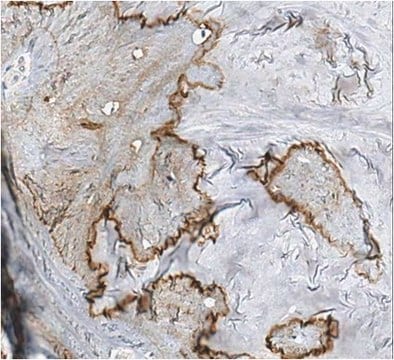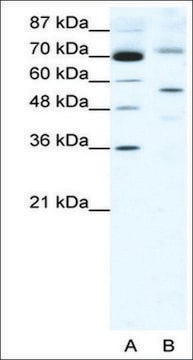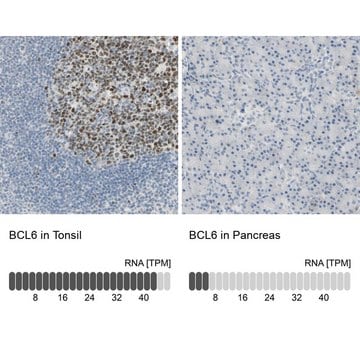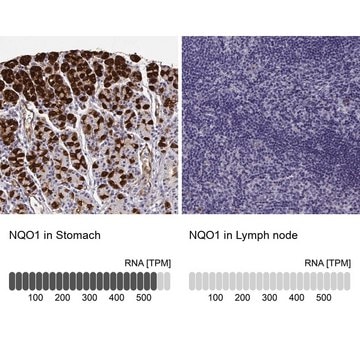추천 제품
생물학적 소스
mouse
Quality Level
항체 형태
serum
항체 생산 유형
primary antibodies
클론
4C5, monoclonal
종 반응성
human
포장
antibody small pack of 25 μL
기술
dot blot: suitable
동형
IgG1κ
NCBI 수납 번호
UniProt 수납 번호
배송 상태
ambient
타겟 번역 후 변형
unmodified
유전자 정보
human ... BGLAP(632)
일반 설명
Osteocalcin (UniProt: P02818; also known as Bone Gla protein, BGP, Gamma-carboxyglutamic acid-containing protein) is encoded by the BGLAP gene (Gene ID: 632) in human. Osteocalcin is a member of the osteocalcin/matrix Gla protein family and can constitute 1 to 2% of the total bone protein. It is synthesized by osteoblasts and is a major component of the noncollagenous bone matrix. Osteocalcin is synthesized with a signal peptide (aa 1-23), a propetide (aa 24-51) that are cleaved to generate active secreted form of osteocalcin (aa 52-100). Osteocalcin displays a high affinity for calcium and binds strongly to apatite. Sixty to ninety percent of de novo synthesized osteocalcin is incorporated into the bone matrix where it binds to hydroxyapatite during matrix mineralization. The remainder of the osteocalcin is released into the circulation where it can be measured as a sensitive marker of bone formation. Osteocalcin found in serum is almost exclusively derived from the bone formation with little or no contribution from the resorption process. A major feature of osteocalcin is the presence of 3 vitamin K-dependent gamma-carboxyglutamic acid (Gla) residues, which are found in the first helical region and interact with the inter-calcium spacing in the HAP lattice. In humans, the percentage of the circulating osteocalcin that is not gamma-carboxylated is used as a biomarker of vitamin K status. Osteocalcin expression in osteoblasts is stimulated by insulin and adiponectin and osteocalcin enhances insulin sensitivity and differentiation in muscle. Serum osteocalcin is elevated in diseases characterized by increased bone turnover such as osteoporosis, hyperparathyroidism and Paget′s disease, and low in conditions associated with low bone turnover such as hypoparathyroidism and growth hormone deficiency. (Ref.: Kanazawa I (2015). World J Diabetes. 6(18): 1345 1354; Gundberg, CM et al. (2012). Adv Nutr 3 (2): 149-157).
특이성
Clone 4C5 detects all forms of human osteocalcin.
애플리케이션
Anti-Osteocalcin, clone 4C5, Cat. No. MABS1989, is a moue monocloanl antibody that detects osteocalcin and has been tested for use in Dot Blot.
Dot Blot Analysis: A representative lot detected 3xGlu, Glu17, and 3XGla peptides for human OCN (Courtesy of Mathieu Ferron, Ph.D., Montreal Clinical Research Institute, Montreal, Canada).
품질
Dot Blot Analysis: A 1:250 dilution from a representative lot detected Osteocalcin at a wide range of concentrations (0.8 to 1600 ng).
표적 설명
10.96 kDa calculated.
물리적 형태
Format: Purified
기타 정보
Concentration: Please refer to lot specific datasheet.
적합한 제품을 찾을 수 없으신가요?
당사의 제품 선택기 도구.을(를) 시도해 보세요.
시험 성적서(COA)
제품의 로트/배치 번호를 입력하여 시험 성적서(COA)을 검색하십시오. 로트 및 배치 번호는 제품 라벨에 있는 ‘로트’ 또는 ‘배치’라는 용어 뒤에서 찾을 수 있습니다.
자사의 과학자팀은 생명 과학, 재료 과학, 화학 합성, 크로마토그래피, 분석 및 기타 많은 영역을 포함한 모든 과학 분야에 경험이 있습니다..
고객지원팀으로 연락바랍니다.








